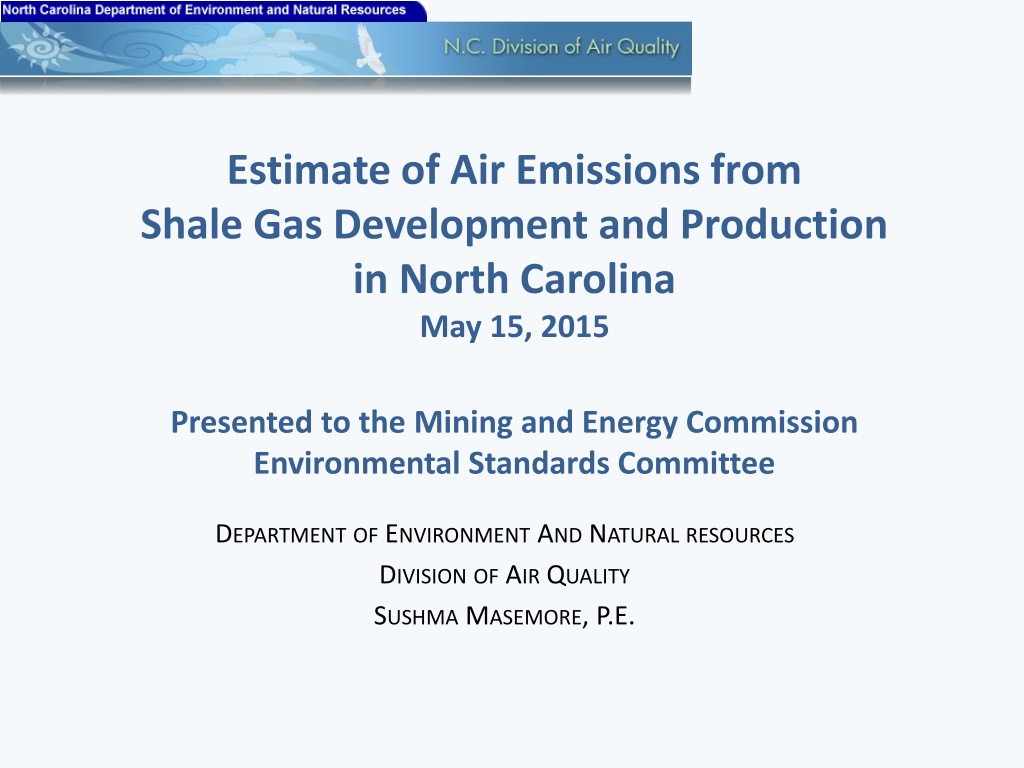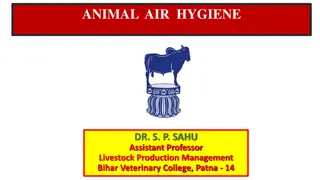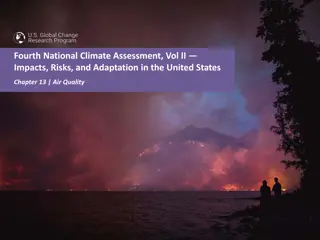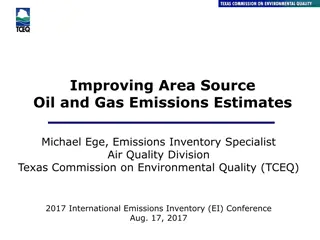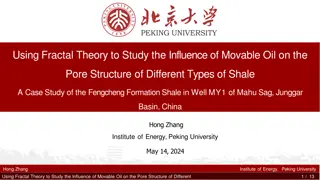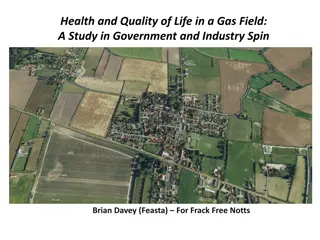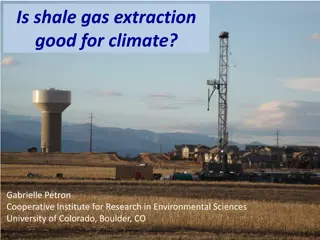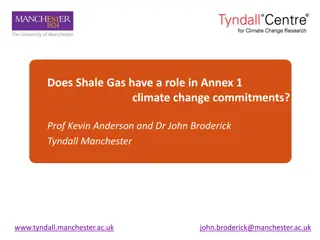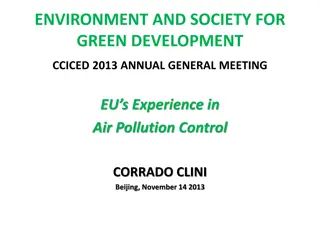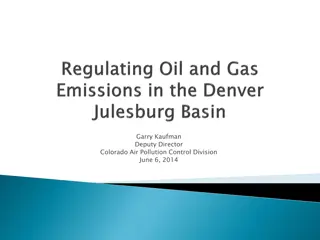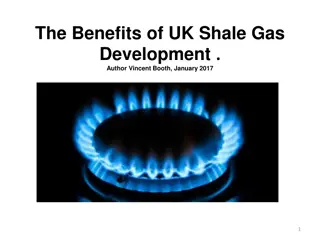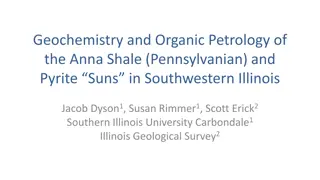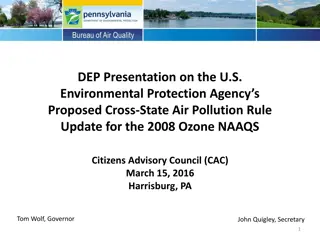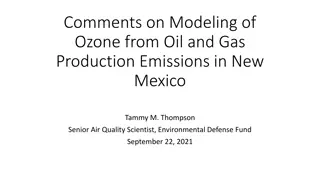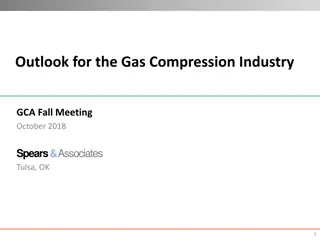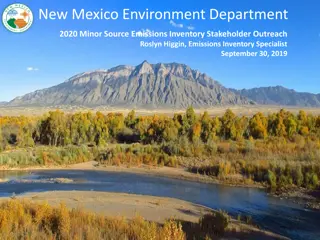Overview of Air Emissions and Quality Assessment in Shale Gas Development
The presentation discusses the estimation of air emissions from shale gas development and production in North Carolina, highlighting the importance of analyzing emissions from oil and gas activities and associated truck traffic. The process involves building emissions inventory, photochemical modeling, and assessing air quality impacts. Emission estimates are based on factors such as activity rate and additional parameters affecting emissions. Various pollutants are inventoried, including VOCs, NOX, CO, SO2, PM, methane, benzene, and more. Ozone formation from NOX and VOC in sunlight is also considered.
Download Presentation

Please find below an Image/Link to download the presentation.
The content on the website is provided AS IS for your information and personal use only. It may not be sold, licensed, or shared on other websites without obtaining consent from the author. Download presentation by click this link. If you encounter any issues during the download, it is possible that the publisher has removed the file from their server.
E N D
Presentation Transcript
Estimate of Air Emissions from Shale Gas Development and Production in North Carolina May 15, 2015 Presented to the Mining and Energy Commission Environmental Standards Committee DEPARTMENT OF ENVIRONMENT AND NATURAL RESOURCES DIVISION OF AIR QUALITY SUSHMA MASEMORE, P.E.
Call for Shale Gas Air Quality Analysis Session Law 2012-143, Section 2(c) as amended by SL 2015-1, Section 6 DAQ required to estimate: 1) emissions from oil and gas exploration, development, 2) emissions from associated truck traffic Determine impact to ozone levels 2
Overview of Air Quality Assessment Process 1. Build Emissions Inventory a. Quantify emissions discharged into the atmosphere 2. Photochemical Modeling a. Emission data input into model along with meteorology b. Quantify formation and transport of ozone and pollutants 3. Assess Air Quality Impacts a. Quantifies increase/decrease in concentration of pollutants b. Impacts to receptors Photochemical Model Air Quality Impact Emissions Inventory + 3
Development of Emission Estimates The general form of the equation for emissions estimation is: E = EF A P Where: E EF A P = emissions = emission factor = activity rate for a specific source = additional parameter(s) affecting source emissions Examples of additional parameters Engine load factor Flare emissions control efficiency Silt content of unpaved road Examples of activity data Horsepower hours Vehicle miles traveled Cubic feet of raw gas throughput For air quality modeling, we assumed an even distribution of emissions during the year: Daily Emissions Rate (ton/day) =Total Annual Emissions (ton/year) 365 days 4
Pollutants Inventoried * Volatile Organic Compounds (VOC) Nitrogen oxides (NOX) Carbon monoxide (CO) Sulfur dioxide (SO2) Particulate Matter - PM10 & PM2.5 Methane (CH4) Benzene (C6H6) Methanol (CH4O) Toluene (C7H8) Hexane (C6H14) Ethylbenzene (C8H10CH2CH3) Styrene (C8H8) Xylene (C8H10) Acrolein (C3H4O) Formaldehyde (CH2O) Acetaldehyde (C2H4O) *where emission factors are available for a given activity Ozone (O3) formed from NOX and VOC in the presence of sunlight 5
Primary Resources Used to Develop North Carolina s Emissions Estimates 1. 2012 DENR Shale Gas Report to the Legislature 2. 2011 US EPA Oil and Gas Tool (updated 2014) 3. 2011 Oil and Gas Emission Inventory Enhancement Project for Central States Air Resource Agencies 4. US EPA AP 42, Fifth Edition, Compilation of Air Pollutant Emission Factors 5. Emission inventories for various states 6
Phases of North Carolina Shale Gas Operations What Types of Sources Were Included? Point - processing plant, compressor station What Shale Gas Operations Did the NC DAQ Evaluate? Development Production Processing Gathering & Transmission Mobile equipment and supply trucks Area drilling/compressor engines, liquid storage tanks Fugitive completion, equipment leaks 7
Shale Gas Phases To Market Well Pad Well Pad Transmission Compressor Station Gas Processing Plant Gathering* Compressor Engines Gathering*, Transmission, and Distribution Development 1 Production 2 Processing 3 4 8
Shale Gas Activity Descriptions Phase Activity or Equipment Reference Section Site Preparation (land clearing, unpaved roads, truck trips, truck idling), Well drilling and completion (drilling, drilling mud degassing, hydraulic fracturing, green well completion) 1 Development Appendix A Compressor engines, Blowdown, Glycol dehydrator, Reboiler, Pneumatic controllers, Heaters, Equipment leaks, Produced water tanks 2 Production Appendix B Acid gas removal (sweetening), Compressor engines, Glycol dehydrator, Reboiler, Liquid removal 3 Processing Appendix C Compressor engines (gathering, booster and high pressure), Pipeline leaks Gathering, Transmission and Distribution 4 Appendix D 9
Key Assumptions: Well Drilling Schedule 1. Gas recovery occurs in the Sanford sub basin (59,000 acres) 2. Cumulative gas produced by the field is 773 Bcf 3. Well spacing of 160 acres, total of 368 wells drilled 4. 4 wells drilled per pad, total of 92 pads 5. Year of maximum activity is Year 6 per Dr. Ken Taylor 121 new wells drilled and 247 producing wells Total produced gas is 151,605 MMcf Each well recovers 2,115 MMcf of raw gas over a 20 year life 6. Water and waste water is trucked within the Sub-Basin 1,000 heavy duty truck trips per well, 100 miles each required Additional light duty truck traffic also estimated assuming 500 trips per well, 50 miles each Bcf = billion cubic feet MMcf = million cubic feet 10
Key Assumptions: Development Phase 1. 2. Four wells per well pad 40 CFR Part 60 New Source Performance Standards and 40 CFR Part 63 and National Emission Standards for Hazardous Air Pollutants regulatory requirements apply Horizontal drilling and hydraulic fracturing are employed. Average drilling time is 200 hours per well. Non-road engines used for drilling and pumping are subject to Federal engine standards (40 CFR 89) Non-road engine emission factors are based on EPA model for 2011. No electrification of drilling pads. 3. 4. 5. 6. 7. 11
Well Drilling Schedule and Gas Recovery Assumptions Drilling Year Year 1 Year 2 Year 3 Year 4 Year 5 Year 6 This table was prepared by DENR s Dr. Ken Taylor Estimate of Year 6 Activity: 121 wells drilled 247 producing wells 151,605 MMcf gas produced Total annual emissions for Year 6 was assumed to be distributed evenly throughout the year to arrive at a daily emissions rate New Wells Drilled 5 23 39 66 113 121 Cumulative Gas (MMcfg) Cumulative Wells Gas Volume per Well (MMcfg) 28 67 134 247 368 Production Year 1 584 2,920 2,920 2 423 2,115 13,432 15,547 3 306 1,530 9,729 22,776 34,035 4 222 1,110 7,038 16,497 38,544 63,189 5 161 805 5,106 11,934 27,918 65,992 111,755 6 117 585 3,703 8,658 20,196 47,799 70,664 151,605 7 84 420 2,691 6,279 14,652 34,578 51,183 109,803 8 61 305 1,932 4,563 10,626 25,086 37,026 79,538 9 43 215 1,403 3,276 7,722 18,193 26,862 57,671 10 32 160 989 2,379 5,544 13,221 19,481 41,774 11 24 118 736 1,677 4,026 9,492 14,157 30,206 12 17 84 541 1,248 2,838 6,893 10,164 21,767 13 12 62 384 917 2,112 4,859 7,381 15,714 14 9 45 283 651 1,551 3,616 5,203 11,349 15 6 32 205 480 1,102 2,656 3,872 8,346 16 5 23 146 347 812 1,887 2,844 6,059 17 3 17 107 248 587 1,390 2,021 4,370 18 3 13 78 182 420 1,006 1,488 3,186 19 2 9 58 132 308 719 1,077 2,301 20 1 6 39 98 224 527 770 1,662 Total Gas Produced by the Field 772,797 12 No new wells are drilled after Year 6
Key Assumptions: Other Phases Production 1. One dehydrator/reboiler and wellhead compressor engine per well pad 2. No recoverable condensate is present in the raw gas. 3. 40 CFR Part 60 and Part 63 regulations apply depending on equipment type, size, age, etc. Processing 1. Regulated as a permitted stationary source 2. All applicable state and federal rules apply 3. Acid gas removal is required Gathering/Transmission 1. 40 CFR Part 60 and Part 63 regulations apply 2. One gas transmission compressor station is regulated as a stationary source 13
Key Assumptions: Raw Gas Composition EPA s National Average Gas Composition (% Volume) Methane VOC Benzene Ethylbenzene Toluene Xylene n-Hexane H2S 83.1 3.66 0.005 0 0.003 0.001 0.155 2.027 Assumption: No recoverable condensates 14
Summary of Results Estimated Annual Emissions of Criteria Air Pollutants Criteria Air Pollutants (ton per year) Phase NOX 735 VOC CO SO2 PM10 199 PM2.5 198 Development 69 316 1 Mobile Contribution* 213 28 195 0.2 6 5 Production 287 882 215 0 4 4 Processing 146 59 34 6.7 5.2E-02 5.2E-02 Gathering & Transmission 176 65 93 0.4 2 2 YR 6 Total Shale Gas Emissions (tpy) 1,344 1,075 658 8.3 205 204 *Shown for illustration purposes; mobile sources emissions are incorporated into Development emissions 15
Potential Emissions Changes Criteria Air Pollutants (ton per year) NOX VOC CO SO2 PM10 PM2.5 YR 6 Total Shale Gas Emissions 1,344 1,075 658 8.3 205 204 Annual Emissions without Shale Gas Development 1,944 1,274 12,720 43 62 370 % Increase in Emissions 69% 84% 5% 35% 330% 55% YR 6 Total Emissions with Shale Gas Development (tpy) 3,288 2,349 13,377 51.3 268 575 16
Annual Emissions of Key Hazardous Air Pollutants by Activity Hazardous Air Pollutants (ton per year) Formaldehyde Acetaldehyde Benzene Toluene Xylene Phase Development 2.4 1.4 0.3 0.5 0.4 Production 7.4 2.7 24.0 0.4 0.2 Processing Gathering / Transmission 13.2 2.1 2.1 1.0 4.0 15.5 2.5 2.5 1.2 4.1 Increase in Emissions 38.5 8.7 28.9 3.1 8.7 18
Relative Contribution of NOX Emissions by Activity 350 300 NOX Emissions (tpy) 250 200 150 100 50 0 Truck Idling Heaters Compressor Engines Compressor Engines Compressor Engines Truck Trips (100 miles) Hydraulic Fracturing Horizontal Drilling Blowdown venting Wellhead Compressor Engines Development Production Processing Gathering Transmission NOTE: Less than 1 tpy or Zero NOX Emissions from the following phases/activities: Development - Land Clearing, Unpaved Roads, Drilling Mud Degassing, and Green Well Completion Production - Produced Water tanks, Glycol dehydrator and associated reboiler, Pneumatic Controllers, Fugitive leaks Processing - Glycol dehydrator and associated reboiler, Vents, Fugitive Leaks & Venting, Acid Gas Waste Sweetening Units Gathering Stations (all) - Glycol dehydrator and associated reboiler, Vents Transmission - Glycol dehydrator and associated reboiler, Vents, Fugitive Leaks & Venting 19
Relative Contribution of VOC Emissions by Activity 140 120 100 VOC Emissions (tpy) 80 60 40 20 0 Truck Idling Vents Heaters Truck Trips (100 miles) Fugitive leak emissions Drilling Mud Degassing Hydraulic Fracturing Compressor Engines Compressor Engines Compressor Engines Horizontal Drilling Wellhead Compressor Engines Blowdown venting Produced Water tanks Pneumatic Controllers Glycol dehydrator & reboiler Still Vent w/Flare Development Production Processing Gathering (all)Transmission NOTE: Less than 1 tpy or Zero VOC Emissions from the following phases/activities: Development - Land Clearing, Unpaved Roads, Drilling Mud Degassing, and Green Well Completion Processing - Glycol dehydrator and associated reboiler, Fugitive Leaks & Venting, Acid Gas Waste Sweetening Units Gathering Stations (all) - Glycol dehydrator and associated reboiler, Still Vents Transmission - Glycol dehydrator and associated reboiler, Fugitive Leaks & Venting 20
Uncertainty Emissions inventory methods for the Oil and Gas Sector are relatively new and constantly changing Quality of emission factors Quality of activity data reported in EPA Oil & Gas Tool There is uncertainty in key parameters Number of wells drilled, Number of wells on a pad Vertical and lateral length of wells Gas throughput and composition Transportation distances Other unknowns Variability in type and age of equipment used Engine type, size, and operating hours 21
Peer Reviewers Mark Gibbs Air Quality Division Oklahoma Dept. of Environmental Quality Ona Papageorgiou, P.E. Bureau of Ari Quality Planning, Division of Air Resources New York State Dept. of Environmental Conservation Allen Robinson, Ph.D. Dept. Head Mechanical Engineering Carnegie Mellon University 22
Next Steps Revise the methodology (if needed) based on Public input Recommendations from the EPA Oil & Gas Emissions Committee Re-run air quality models 23
